
How To Persuade Legacy Companies To Digitally Transform
To compete today, organizations need digital investment to deliver a better customer experience. But many teams at enterprise-sized companies are stuck with dated systems.
Often, the delay to keep up with technological progress comes from old-school leadership sticking to what’s always worked. Other times, it’s a disconnect between departments.
In this article, I’ll provide tactical advice on how to get and maintain internal buy-in for digital transformation.
I’ll go beyond the typical high-level framework and provide a tailored strategy to put a digitally averse organization on the path to transformative success.
Table of contents
Step 1. Make the case for digital transformation
According to Deloitte, organizations require at least a 10% revenue investment to initiate a digital transformation that positively affects earnings before interest and taxes (EBIT).
Say your company turns over $6 billion per year. Approximately 10% of that figure is $600 million—just to meet the minimum investment for an effective transformation.
To argue your case for the vast sum of money you require, you must back up your proposal with hard data.
We can break down digital transformation into four crucial areas that leadership teams value:
- Competitive advantage
- Cost savings and increased profitability
- Talent acquisition
- Risk mitigation
Competitive advantage
According to Boston Consulting Group, legacy companies that have not completed a significant digital transformation underperform against legacy companies that have.
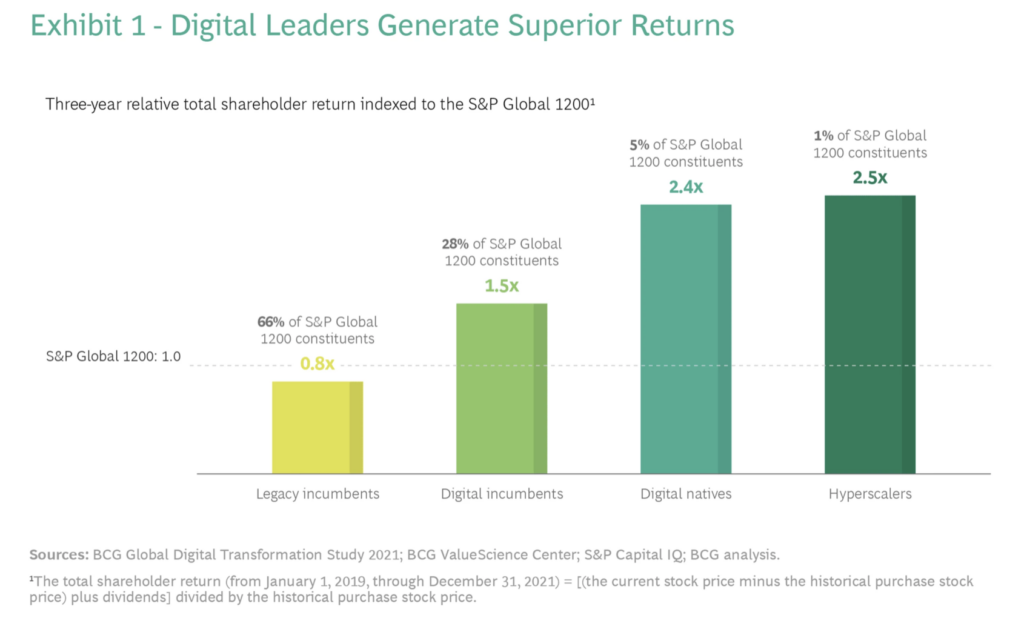
Source: BCG
These outperformers poise themselves to strengthen their competitive advantage. Their digital investments provide a strong foundation for quickly adopting new technologies such as generative AI and Web3.
As technological innovation accelerates, companies that haven’t achieved a basic digital transformation will fall further behind.
Cost savings and increased profitability
In another 2021 study from BCG, digital transformations generate “clear and significant financial impact.”
Companies that addressed the factors it takes to make these transformations successful (including a clear, integrated strategy and adopting an agile governance mindset) reported a 21% EBIT increase.
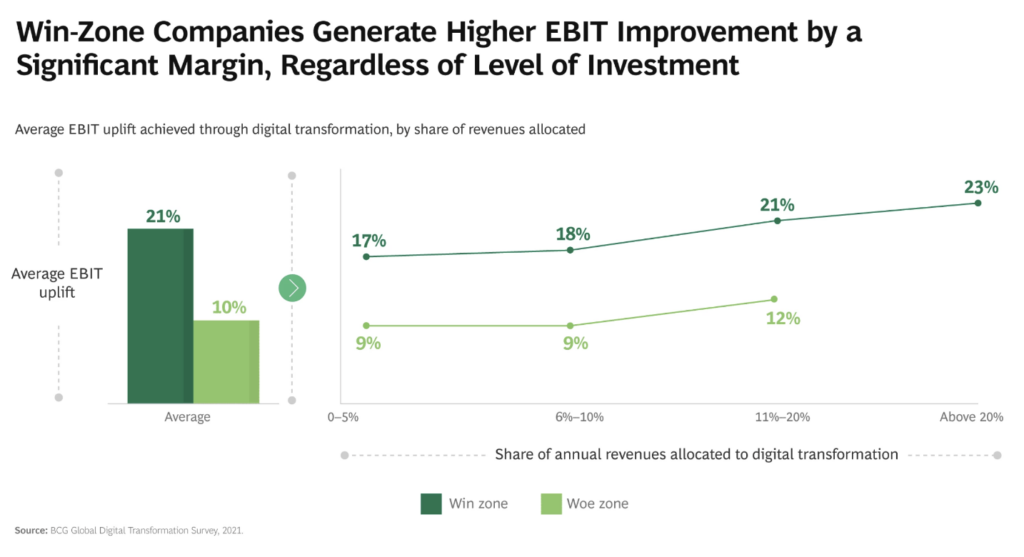
Source: BCG
Deloitte also reports that digital maturity drives profitability in its 2022 Digital Maturity Index.
Digital “champions” (those who combine a consistent digital strategy with operational excellence) report up to a 16% uplift in EBIT.
Conversely, “laggards” (who lack digital skills) report a 3% decrease.
Talent acquisition
Hiring a leader familiar with the technology you’ll be using, such as a chief digital officer (CDO), is a common key to success. According to McKinsey, organizations that hire a CDO are 1.6x more likely to report a successful transformation.
While talent acquisition may not come in the form of a CDO, nearly 70% of respondents in the same report said their company’s top team changed during the transformation.
Humans are naturally resistant to change. It’s this threat to people’s careers that management likely fears.
While you need digital-savvy leaders to drive a successful transformation, they also need to work with those who understand the organization as it is now. See new talent as a way to supplement internal capabilities, upskill everyone, and encourage humility.
Risk mitigation
According to studies by cloud email security platform Tessian, 85% of data breaches are due to human error, and 43% of people have compromised cybersecurity with personal mistakes.
Top Tip: A widespread data breach that led to a 40% drop in profits motivated Target’s digital transformation. Learn how going digital set the retailer up to weather future crises in our deep dive 🐼
When you rely on human-heavy processes, as is common in legacy systems, you’re opening yourself up to an array of mistakes.
Instead of waiting for disaster to strike, be proactive by implementing an agile approach to your digital transformation strategy.
This involves breaking down your process into shorter, more achievable tasks with a focus on experimentation.
When you undertake this kind of governance, you learn to expect anything “outside of the norm” and are far better prepared to handle it. Whenever potential risks arise, you can be quick to assess and respond to them.
Step 2. Build a digital culture from leadership down
It’s challenging to build a digital culture in a legacy organization. For your transformation to succeed, you need buy-in from everyone—from your CEO to your most junior employees.
Here are three tactics to help bring everyone in your organization around, regardless of their level:
- Communicate and maintain leadership buy-in
- Involve and empower employees
- Foster an agile culture of experimentation
Communicate and maintain leadership buy-in
Commitment and involvement from leadership (from the CEO to middle management) are crucial for the success of your digital transformation goals. You can’t separate the process from daily operations. Everyone has to see it as the future of your organization.
The DT process comes with lots of new jargon that senior leaders may be unfamiliar with. Breaking these down into simple terms is one of the fastest ways to bridge the gap, remove frustration, and replace it with approval.
Alongside these simplified technical problems, present a list of solutions and associated costs to help leaders feel less overwhelmed. Organize these into a clear plan and prepare yourself to defend them against other legacy solutions by demonstrating the value of a digital approach.
One of the biggest pushbacks to digital change from management is the fear of their roles becoming redundant. As organizations adopt new technology and operating models, senior leadership must take care to adjust middle-management career paths and communicate any changes effectively and compassionately.
Involve and empower employees
For employees to truly embrace digital transformation, you need to involve them in the process from the start.
McKinsey confirmed this by identifying a series of key factors that contribute to tripling the likely success of digital transformation—several of which relate to employees.
These are:
- Encouraging employees to experiment with new ideas
- Encouraging employees to challenge the old ways of working
- Implementing digital self-service technology for employees
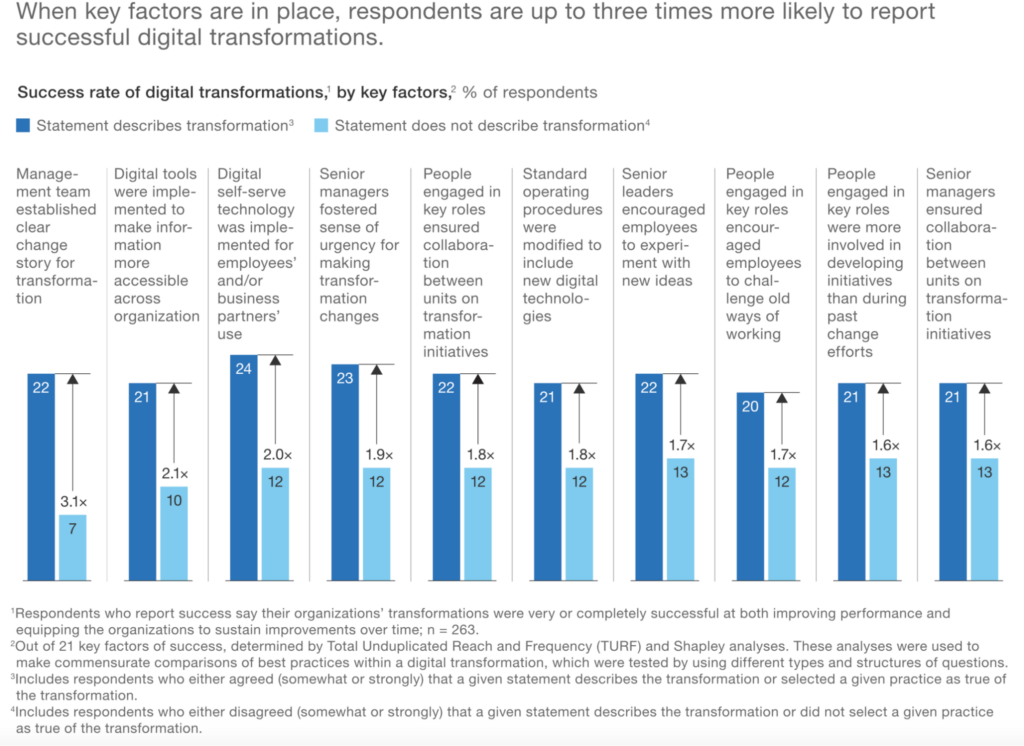
Source: McKinsey
Employees will likely feel the most significant shift when you digitally upgrade their day-to-day tools and operations. That’s why it’s important to assist them with training and support. While some will respond positively and welcome the change, you’ll always encounter pockets of resistance.
These findings indicate the importance of bringing every level of the organization into the transformation process.
It can also help mitigate any resistance—from providing employees with context for why you’re changing their working world to involving them in idea sessions and decision-making.
If they feel their opinions and feedback matter, the shift may not feel as fast or extreme. You could also catch potential issues that arise from rushing through a strategy without broader input.
When companies allow employees to suggest where digital transformation may support the business, McKinsey found they’re 1.4x more likely to report success.
Once change is underway, it’s crucial to celebrate successes and reinforce positive new behavior.
You should encourage employees to learn from their failures and recognize and appreciate small wins. When someone achieves a goal in line with new behaviors, celebrate it to reinforce it to the rest of the team.
Foster an agile culture of experimentation
Technology constantly evolves, so your organization must continuously innovate alongside it. Fostering an agile digital transformation culture can make this transition more seamless.
Let’s say the initiatives you map out don’t work in practice, or the market and customer needs shift (as they always do). Instead of wasting money and resources on a strategy you can’t pivot, an agile culture allows you to learn and re-launch as you progress.
The agile approach ensures that change will become part of your routine (instead of something to dread), assisted by your digital tools.
Once you have them in place, you can get comfortable with experiments of every size—from trying out new organizational structures to testing different elements of your online customer journey.
Top Tip: Learn how to understand and nurture the entire customer journey with our guide to the considered purchase journey 🐼
Experimentation was crucial to Related Companies’ successful digital transformation. We used web experimentation platform Optimizely to make effective tweaks to campaign landing pages which led to a 26% increase in lead conversions.
We also used Salesforce Marketing Cloud’s built-in A/B testing module to optimize user engagements with emails and increase engagement by 15%.
To experiment effectively and achieve quantifiable business outcomes, align your internal departments and combine them in cross-functional teams.
Here’s what that could look like on the operational side:
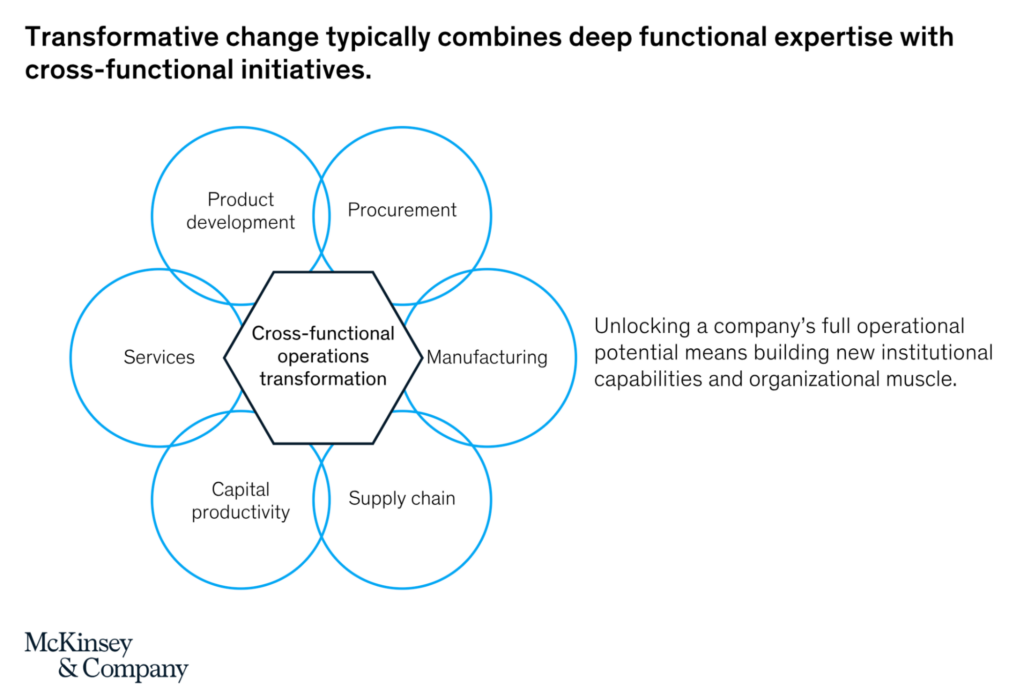
Source: McKinsey
You can also use this strategy to market your offer more effectively. For example, your IT department could help your marketers understand the available data, and marketing could better explain what they’d like to do with it.
Step 3. Measure and prove the value of digital transformation
Now you have the tools to build an agile, digital culture from the top down. After that, you’ll need to solidify a way to measure important metrics and prove the predicted value of your strategy on an ongoing basis.
Here are three ways to do that:
- Identify relevant KPIs based on leadership’s priorities
- Demonstrate quick wins through pilot projects
- Engage with customers to gather insights, feedback, and preferences
Identify relevant KPIs based on leadership’s priorities
Key performance indicators (KPIs) are integral to any business strategy. They’re also imperative when trying to measure, and prove the value of, your new digital transformation strategy to leadership.
You can track many different types of KPIs on your path to digital transformation. Here are a few of the most popular:
- Employee productivity. This KPI is a good indicator of whether your new digital tools help or hinder your workforce.
- Return on digital investment. While this will take time to appear, it’s how you can prove to leadership that your new technology was worth the upfront costs.
- Customer experience. If your customers don’t like the change, it’s unlikely to last. (I’ll cover customers in more detail soon.)
- Operational expenses and efficiency. Comparing your new processes to your old ones lets you pinpoint when increased productivity and savings will outweigh the initial cost.
- Workforce morale. If your employees don’t adapt to the change (or even resist it), it could impede the success of your transition.
When choosing your KPIs, it’s important to identify the ones your leadership team prioritizes. For example, you may have won them over by discussing the cost savings that come with a digital transformation. If that’s the case, you could decide to track efficiency gains, cost reductions, or throughput.
Along with those priorities, here are some questions you should ask yourself when choosing your KPIs:
- What’s the desired business outcome of this KPI?
- Is the goal for this KPI achievable?
- Can this KPI be easily measured and understood?
- Does this KPI address a specific audience?
- Do I have a suitable platform to track this KPI?
The final question’s answer should always be “yes.” You need a secure digital platform to manage and track your KPIs effectively.
There are many different options for these. You could use marketing analytics platforms like Mixpanel and Heap Analytics or a customer data platform like Blueshift. It depends on the metrics you want to track and the interface you find the most user-friendly.
Demonstrate quick wins through pilot projects
One of the main objections to digital transformation is that it seems like a daunting process. To mitigate this, consider undertaking smaller pilot projects instead of diving into digitization on a large scale.
In addition to being more achievable, these “quick wins” can give your team confidence in the wider strategy. If you still have skeptical employees or members of leadership at this stage, the success of these pilot projects should tackle any remaining resistance.
So, how do you plan a digital pilot project that’s likely to succeed? Follow these six steps:
- Surround your project with the right people. That means leaders who can approve budgets, employees who’ll make it happen, and the end-users to give feedback.
- Start with a small-scale problem. Pick a project that’ll take a few months instead of years to get results faster.
- Clarify what success will look like. Choose clear goals and KPIs so that you’ll find it easier to measure progress accurately.
- Use a “sprint” framework. In this software development tactic, you break up your project into smaller tasks with aims to achieve them within a set timeframe.
- Don’t forget to evaluate. Review your project and note where and why you followed, or deviated from, the plan. Couple this with user feedback to assess the process.
- Keep up the momentum. Use what you’ve learned from this project to dive straight into planning the next (more effective) pilot project.
Consider adding data-driven visualizations like graphs, charts, and maps to share your pilot project process and results in the most user-friendly format.
Here’s an infographic that visualizes the digital transformation of the insurance industry as a result of the COVID-19 pandemic:
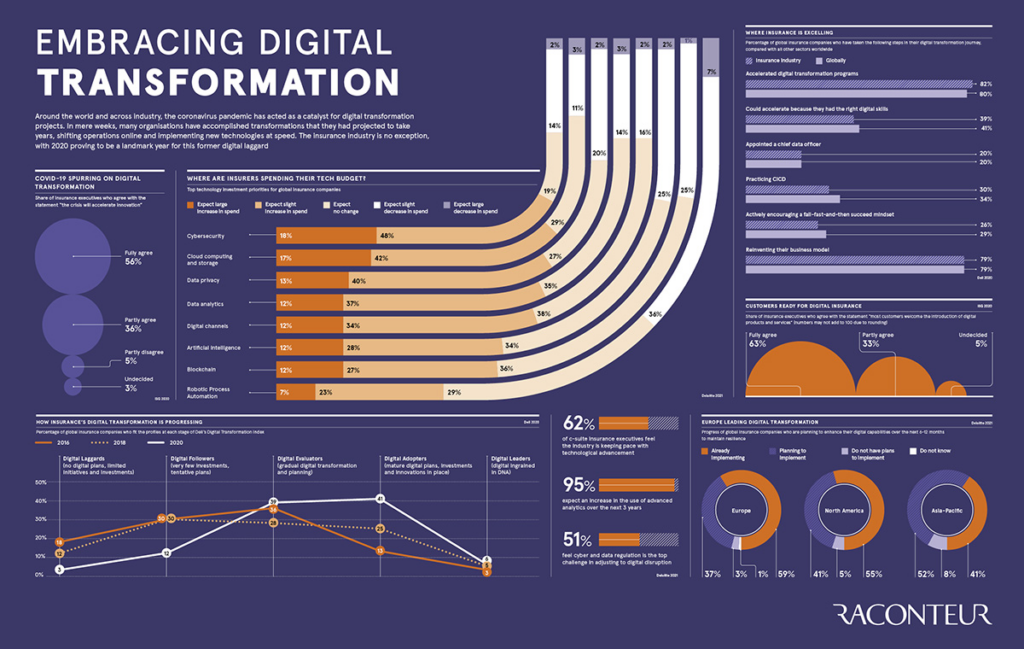
Source: Raconteur
While using non-IT language is essential, visualizations can help drive home your pilot project’s success and get leadership on board for a wider rollout.
Top Tip: Quick wins are great, but digital transformation doesn’t stop there. Create a long-term plan with our guide to creating a digital transformation roadmap 🐼
Engage with customers to gather insights, feedback, and preferences
One critical group I haven’t mentioned until now is your customers. Long-term success relies on their engagement with your new offering.
Findings from McKinsey suggest building a digital transformation strategy around your customers can lead to economic gains ranging from 20-50%. Not to mention a 20-30% increase in customer satisfaction rates.
On the other hand, if they don’t adopt and buy-in to your new digital products or services, you’ll struggle to stay profitable.
As well as tracking customer-focused KPIs such as daily or monthly active users of your new service, you need to find out how they feel about it. Surveys are one of the most popular and effective methods. You can go down the manual route and ask a sample group in person, or use automated tools to widen the net.
- Customer satisfaction (CSAT)
- Customer effort score (CES)
- Net promoter score (NPS)
Once you roll out your pilot projects, the above metrics will give you a good indicator of how customers feel about them.
Surveys and metrics can help you get the opinions of large sample sizes with less effort, but you can gain a lot by going down an even more direct route.
One-on-one or group interviews can reveal much deeper insights. When you hear the same positives or pain points from several people, you have enough evidence to adjust your processes to shift away from, or lean more heavily on, the responsible factors.
Top Tip: Listening to customers is a key tactic in the New York Times’ ongoing evolution. Learn more about the newspaper’s successful digital transformation 🐼
Key takeaways
The shift to digital-centric processes isn’t going to stop. In fact, it’s accelerating. Even if your legacy company is getting by for now, those who don’t keep pace with this fast-evolving technology will soon be left behind by those that do.
This change shouldn’t be something to fear. Shifting your organizational culture toward a digital future better prepares everyone for the evolution of work.
Along the way, it’s vital that you don’t view digital transformation as a one-stop shop. It’s an ongoing journey that involves hiring new tech talent and upskilling your current workforce to become more tech-savvy.
However you do it, your entire leadership team has to be not only on board with the process, but the driving force behind it. Without their complete dedication, you could put considerable time and resources at risk.
READY TO PROVIDE A BETTER POST-CLICK EXPERIENCE?
Get insights and tips to drive more business from less ad spend, more profit from less cost, and more customer value from less churn.